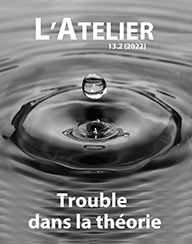Reading in the Dark: After Theory
Résumé
Since Heidegger’s explicit critique of theoria “as a looking-at that sunders and compartmentalizes”, philosophy and critical theory’s use of metaphors drawn from vision have continued to dwindle and darken. If, in 1968, in the days “before Broadway became a boulevard of theory”, Hannah Arendt could still name the English translation of Benjamin’s essays of literary criticism Illuminations, her preface nevertheless takes care to foreground Benjamin’s analogy of the literary critic as alchemist of the funeral pyre of literature, one who in dark times continues to “inquire about the truth whose living flame goes on burning over the heavy logs of the past and the light of ashes of life gone by”. In the 1980s and 90s, against the dark forces of subjection bound up in Foucault’s ocularcentric metaphor of the “panopticon”, and as both a symptom of, and protest against, the linguistic turn and the “phallologocularcentrism” of dominant discourses, what Martin Jay called the “downcast eyes” of post-structuralist theory turned increasingly towards metaphors drawn from the sense of hearing. If Foucault’s critical discourse analysis of the triad “power/knowledge/subjectivity” cleared a space for otherwise silenced voices to be heard, critical theory, with Derrida, Irigaray, Spivak, Deleuze, and Bhabba, would listen “with the ear of the Other” to stuttering in the interstitial non-spaces of différance between seeing and speaking, writing and reading.
Téléchargements
Publiée
Numéro
Rubrique
Licence
-
L’envoi spontané d’un article à la rédaction de L’Atelier implique l’autorisation de publication et la cession des droits dans les limites établies par la loi de propriété intellectuelle.
-
L’Atelier conserve les droits de reproduction des articles publiés, quelque soit le support : internet, CD ROM, réimpression, photocopie, etc.
-
L’auteur conserve le droit de publier ultérieurement son article déjà paru dans L’Atelier avec la seule obligation de mentionner le nom de la revue comme source de la première publication.


